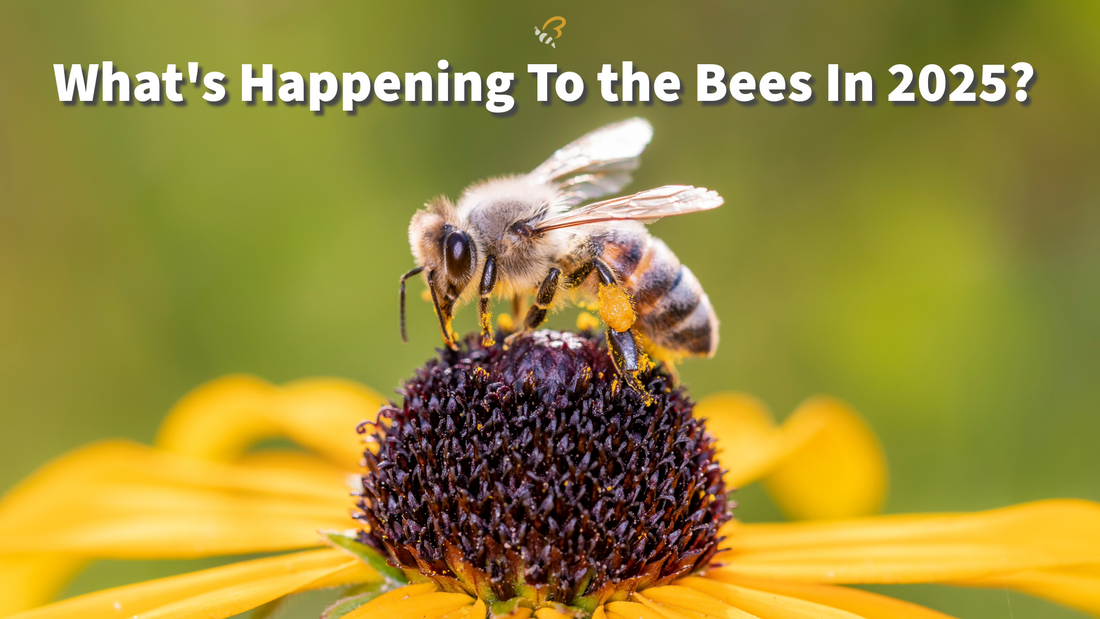
What’s Happening To The Bees in 2025?
Share
Last week, entomologists at Washington State University forecast that total honeybee losses this year could reach up to 70%. Over the past decade, annual losses have typically been between 40% and 50%, but the numbers have been “increasing steadily” as time goes on, the report said.
Until about two decades ago, beekeepers would typically lose only 10–20% of their bees over the winter months, according to The Guardian article.
Climate change, urban sprawl, and widespread weed killing were all cited as factors in bee decline, according to Project Apis m.
The U.S. Department of Agriculture is also studying whether bee-killing viruses or parasites could be contributing to the devastating losses, while Cornell researchers are looking into the impact of pesticides.
The U.S. Beekeeping and Agriculture industries are in crisis over the shocking and unexplained deaths of hundreds of millions of bees over the last half year.
Blake Shook, one of the nation's top commercial beekeepers, has found tens of thousands of dead bees at his businesses, saying, “he's never seen losses like this.”
"The data is showing us this is the worst bee loss in recorded history,"
— Shook told "CBS Saturday Morning."
However, researchers are still grappling for answers as to what’s causing the deaths.
Juliana Rangel, an entomologist at Texas A&M University, has been studying bee hives in their lab.
“There are a few potential explanations,” she said, “including changing habitats and weather patterns. But there’s no certain answer.”
“If this is a multi-year thing, it’ll change the way we consume food in the United States,” Shook said.
“If we lose 80% of our bees every year, the industry cannot survive, which means we cannot pollinate at the scale that we need to produce food in the United States.”
One of Shook’s businesses focuses on rebuilding dead hives. He’s receiving an alarming number of those hives, he said, from commercial operations across the country. Beekeeping groups say 25% of those commercial operations may be put out of business by year’s end because of the losses.
“I got a call from a friend who had 20,000 beehives at the start of the winter, and he’s at less than 1,000. He said, ‘This is it, I’m done.’ I’ve had far too many of those calls in the last few weeks,” Shook said.
“It’s not just a beekeeper issue. This is a national food security issue.”
According to a preprint posted to the bioRxiv server this month, nearly all the dead colonies tested positive for bee viruses spread by parasitic mites. Alarmingly, every single one of the mites the researchers screened was resistant to amitraz, the only viable mite-specific pesticide or miticide of its kind left in the beekeeper’s arsenal.
Miticide-resistant varroa mites have been a growing issue for beekeepers for years, so much so that breeders have sought to develop mite-resistant bee varieties. Since the 1980s, the parasites have evolved global resistance to at least four major classes of miticide.
Unfortunately, effective new compounds are notoriously difficult to develop, and Amitraz represented one of the best remaining treatments. But the preprint suggests Amitraz could soon become obsolete and completely ineffective.
We think somebody should tell all these experts about 4Rbees, because we have a proven, all-natural, organic method of keeping bees healthy and strong.
And we also provide organic bio-diversity so all diverse pollinators can thrive as well!
So do you want to save some bees today?
Shop now and get 20% off and support our mission to help save the bees and the planet organically!
Use the discount code SAVEBEES at checkout.
Just for fun: Watch these 2 bees work together to get a bottle cap off to get to the sweet sugary soda pop!
🎥 https://youtu.be/p8fspqCKiVM
References:
Washington State University Insider
Beekeepers Work to Restore Bee Population
Dead Bee Colonies Testing Positive for Bee Viruses Spread By Parasitic Mites
Breeding Honey Bees To Fight Deadly Virus
Evaluation of Miticide Toxicity



